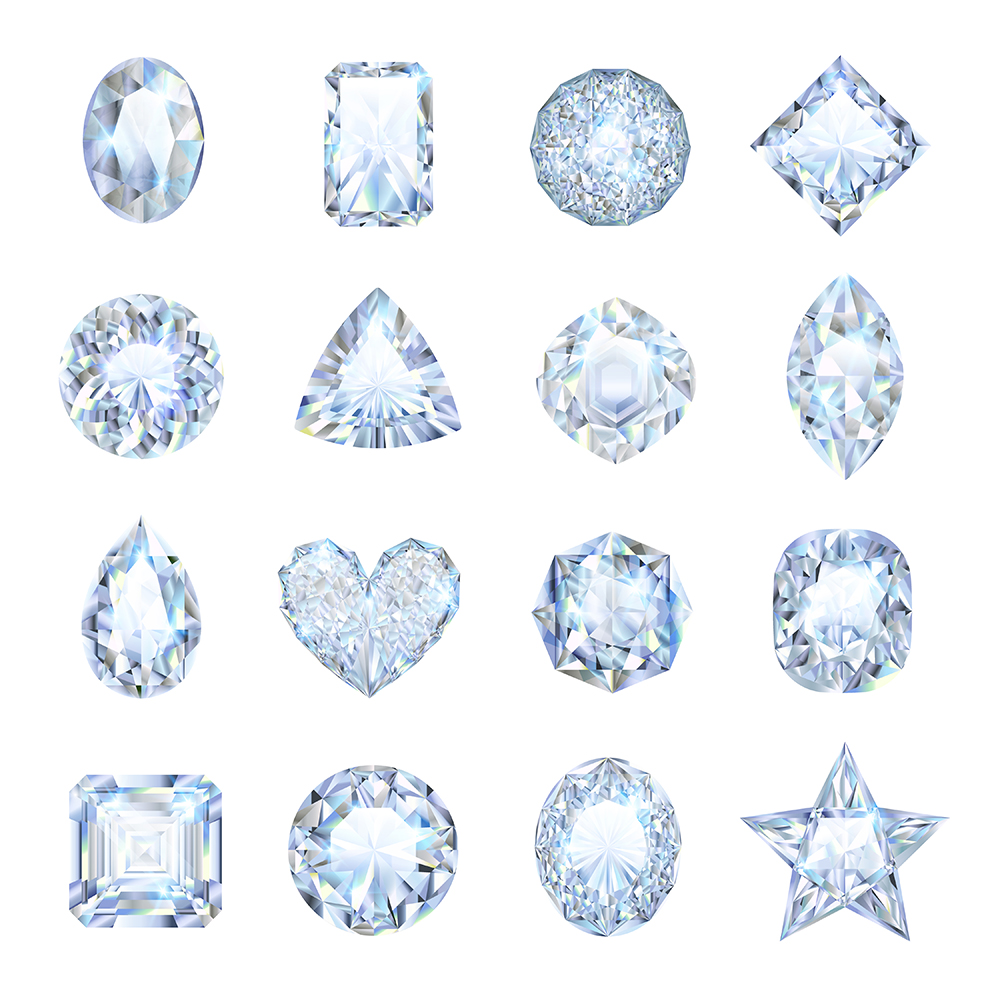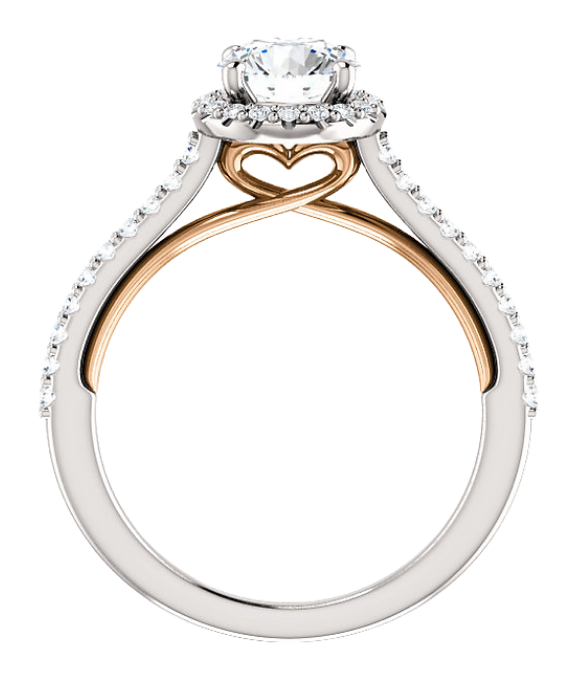The Diamond Cut Guide
The 4 C’s of Diamonds define the primary characteristics that determine the quality and value of a diamond. Created by Robert M. Shipley, the founder of the Gemological Institute of America (GIA), the four C’s stand for:
- Cut: Graded on a GIA scale of Excellent to Poor and Ideal to Poor according to the International Gemological Institute (IGI) scale.
- Colour: Graded from colourless (D) to light yellow or brown (Z).
- Clarity: Determined according to internal and external imperfections of the diamond. Graded on a scale of Flawless (FL) to Included (I).
- Carat: Measured in metric carats (1 carat = 0.2 grams).
The 4 C’s
Diamonds are evaluated according to these factors, and all 4 C’s influence the overall look and price of the stone.
The 4 C’s
Diamonds rekindle the idea of passion, fire, scintillation and brightness. The best diamond cut depends on the craftsmanship of the cutter. It directs how the facets of the gemstone will correspond to light. The mastery of the cut mirrors in the dynamic colours that the stone reflects. The cut of every diamond is assessed based on:
- Proportions
- Symmetry
- Polish
Diamond clarity vs. colour depends on how good the cut is. It is worth noting that the cut and shape are two different concepts. Shape defines the diamond’s outline. It can be round, oval or princess.
Colour
The GIA diamond colour scale grades the stone’s tint from colourless (D) to a light shade of yellow or brown (Z). Each alphabet shows a subtle change in the colour saturation. Completely colourless diamonds are considered the most valuable and rare. The ones you find today, blue and pink, fall beyond these colour grades. They need a different scale for grading.
The colour of the diamond can significantly impact its appearance and shine. The colours get more noticeable as the carat weight increases, particularly in different light settings. Choosing the right colour is more of a strategic decision. It must match the ring design, the buyer’s taste and preferences.
Clarity
The diamond clarity chart grades diamonds on a scale from Flawless (FL) to Included (I). It refers to how many inclusions (internal imperfections) or blemishes (external inclusions) a diamond has. Clarity determines a diamond’s quality and value. Going by the scale, FL means there are no visible imperfections, and I mean there are visible imperfections.
It is rare to find diamonds that have fewer or smaller inclusions and are considered highly valuable. Inclusions can affect the shine of the stone, putting barriers in the way of the light that passes through. Some are microscopic and go unnoticed, while others add more beauty and uniqueness to the diamond. This makes stones with the most clarity expensive.
Carat
Carat is a measurement unit which refers to a diamond’s weight. This does not mean that carat defines the diamond’s appearance. Moreover, even diamonds of equal weight may look different. The overall look of the stone depends on the artistry of the diamond cutter to define it with their craft of shaping and cutting.
Even when you look at carat vs. clarity, it is the shaping of the diamond that makes the stone look larger and shine brighter. The most valuable thing the carat weight helps determine is the price of the diamond. The larger the stone, the more expensive it is.
Diamond Shape
The look of a diamond when viewed from above defines its shape. Many think shape and cuts are the same. Cuts, on the contrary, are the facets which affect how the stone interacts with light. Diamonds come in different shapes, with Round Brilliant being the most popular. All other shapes that you see are modern crafts.
Each shape has its own style, with the Round Brilliant having more of an evergreen style and the Cushion shape having a more vintage look. The diamond’s shape also affects its size, so some shapes look larger. Picking a perfect shape depends on the buyer’s choice, the kind of setting and the characteristics of the diamond.

Diamond Size
A diamond’s size is measured in millimetres, which vary in width and height. Although many refer to size and carat as the same, there is no diamond carat or size comparison. Size refers to how the diamond looks. For a larger diamond, carat weight increases automatically, but the size might be impacted by the shape and cut, too. A well-cut diamond can seem larger than a similarly sized diamond with a poorer shape.
The stone’s look and value cannot be determined by the size alone. Three of the Cs – cut, clarity and colour impact its appearance. Size would not matter if a skilled artisan cut the diamond. It can make even a small stone outshine a larger one. To get the best value on your purchase, make sure all the 4 C’s balance with the size.
Diamond Types: Lab Grown Vs. Natural Diamond
| Aspect | Lab Grown Diamonds | Natural Diamonds |
| Origin | Professionally made in laboratories using advanced technology. Creating these diamonds takes a few weeks. | Naturally formed within the Earth’s crust due to heat and pressure over a billion years. |
| Composition | Chemically and physically, they are the same as natural diamonds. | Composed of a single element, which is 99.95% carbon. |
| Price | They are 20 to 40 percent more affordable than natural diamonds of similar quality. | They are expensive because of their rarity and mining costs. |
| Appearance | Has the same sparkle and brilliance as natural diamonds. | They are visually indistinguishable from lab-grown diamonds. |
| Ethics | They are conflict-free and the production process is transparent. | There are some risks of conflict diamonds and unethical mining. |
4 C’s of Diamonds Tips
Are you still confused about “How to choose an engagement ring?” Check these essential tips to master your understanding of the 4 C’s:
Cut
- Pay more attention to the cut quality than the stone size.
- Choose diamonds graded as Ideal or Excellent.
- Do not go for the carat weight; understand how the cut affects the shine and look of the stone.
Colour
- Choose a nearly colourless stone for better value.
- Explore different settings to match the colour of the stone.
- If you prefer a white appearance, avoid diamonds graded below J.
Clarity
- Select diamonds where inclusions are not easily visible.
- Choose diamonds that offer a balance of clarity and price.
- If possible, use a magnifying glass to check the stone’s clarity.
Carat
- Apart from the weight, also consider the cuts and ideal diamond proportions.
- If you are looking for affordable choices, choose diamonds below standard weight marks.
- The size of the diamond must complement the setting and match your preferences.
General Tips
- Keep your priorities straight and set a budget to balance the 4 C’s.
- Select GIA-certified diamonds.
- To understand the differences, compare different diamonds by setting them side by side.
- For expert advice, consult with an experienced jeweller.
Frequently Asked Questions
Of all the four C’s in a diamond, the cut is the most important. Here’s why – it directly affects the sparkle and brilliance of the stone. The amount of light the stone gets through it will depend on how well the diamond is cut. It also improves the overall look and quality of the piece.
Both types are composed of the same chemical and physical properties. With your naked eyes, it is hard to find out which one is a mined diamond and which is a lab-grown diamond. The best way to determine is to request your jeweller to check which type your choice of stone falls into.
Many think the sparkle defines what diamond clarity is. But, no, they are not the same. Clarity refers to the imperfections the diamond has (both visible and invisible to the naked eye). The sparkle actually comes from the cut of the diamond.
There are different certifications available that guarantee the diamond’s quality and authenticity. While the GIA certification is most common, there are other certifications you may seek from your jeweller.
Yes. We highly prioritize that in our store, you get only the best. The supplier we deal with follows ethical practices, and while acquiring these precious stones, we make sure to adhere to strict standards.

Get in Touch
Loved one of the styles above but want it customized. Email us below with the style, your desired metal and gemstone colour and we will make it happen!
